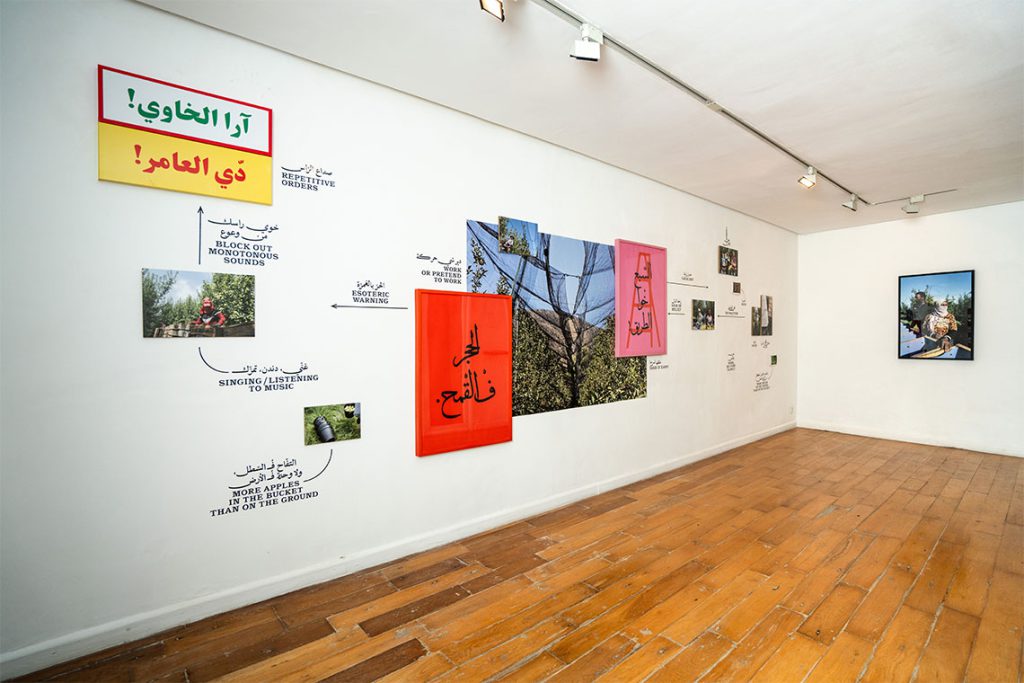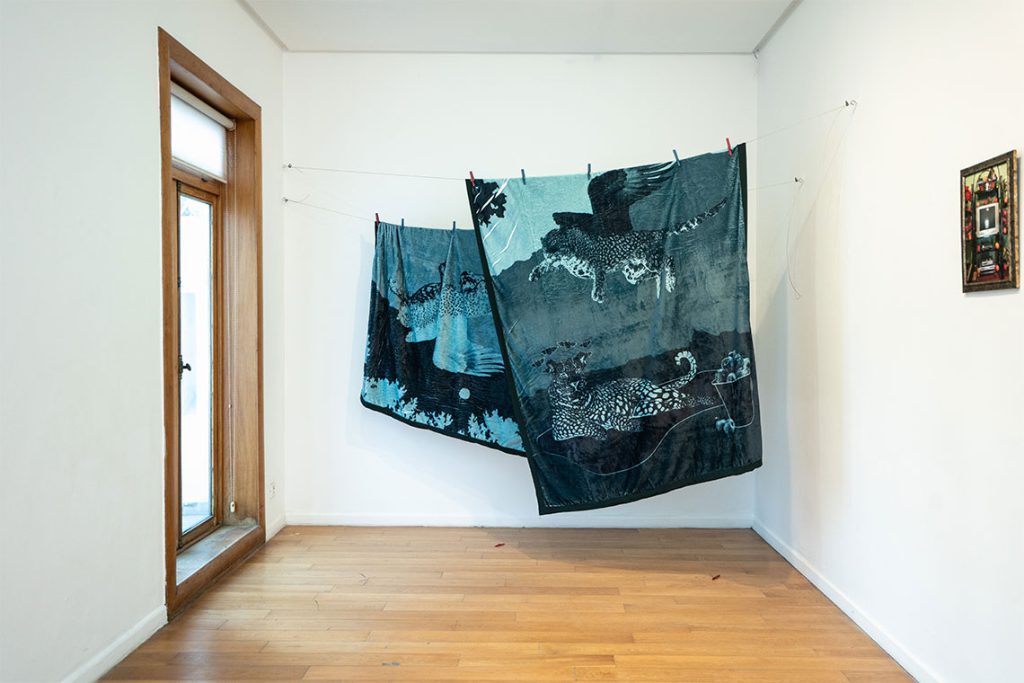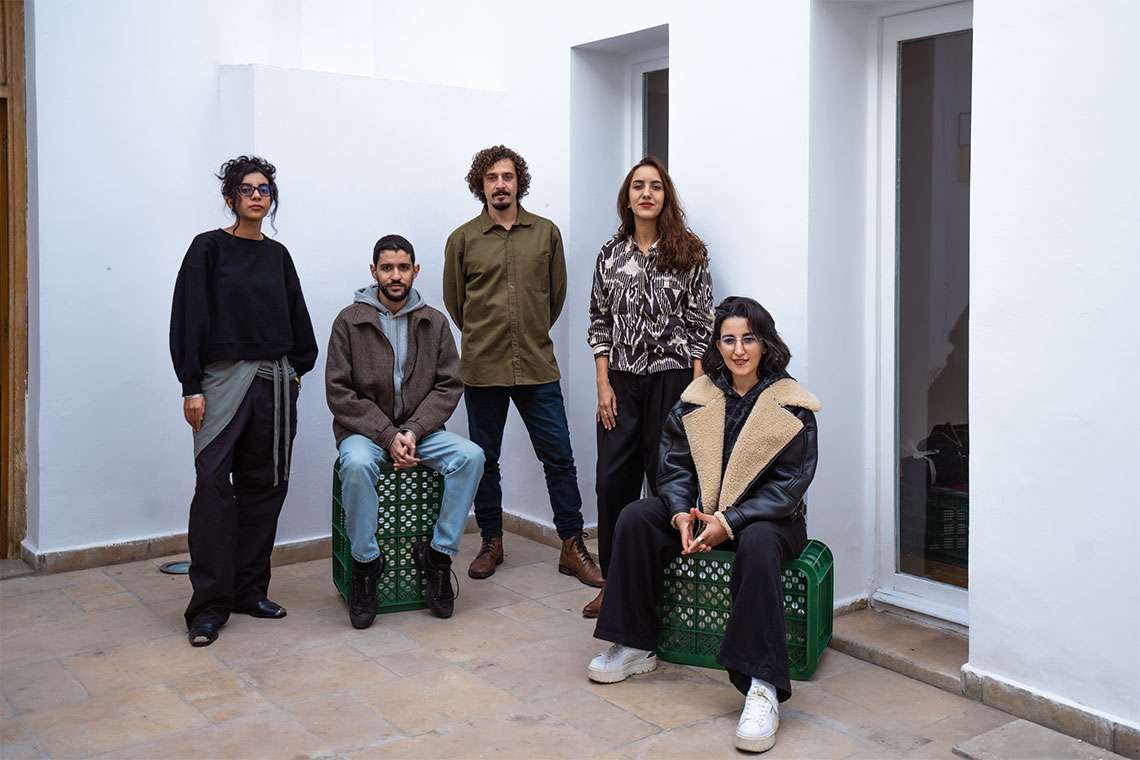The collective’s Nadir Bouhmouch discusses the group’s recent show Remedies for Monotony at Villa Delaporte and talks about self-curation and the politics of Darija.
Canvas: Perhaps we can start by discussing the Against Monoculture project that you’ve been working on for the past few years, and how it led to Remedies for Monotony?
Nadir Bouhmouch: Against Monoculture was something that came out of our observations of both agricultural production and cultural production and specifically from fieldwork we were doing in the Atlas Mountains to collect oral poems, stories and legends. We were travelling there a lot, over many years, and started to notice changes in the biological landscape of the valleys. Incrementally, we saw how apple monocultures were slowly taking over.
Since we were recording ancestral art forms at the time, we realised that the homogenisation of crops went hand in hand with the homogenisation of culture. People were increasingly consuming the uniform products of the centre, of the metropolis – whether that’s Casablanca or the West. Culture was being transformed in a manner that is akin to that in which the metropolis dictates agricultural policies.
Remedies for Monotony emerged from this observation as a project which examines the human experience within this homogenised landscape. We thought that one of the best ways to do that was to focus on the workers who are actually labouring within these apple monocultures.
The collective has expanded. Where it was previously just yourself and Soumeya Ait Ahmed, but you’re now collaborating with Oumaima Abaraghe, Montasser Drissi and Houda Jouaij. What brought about this change?
It was actually Montasser who asked Soumeya and I this question: “Why do you call yourselves a duo when you’re constantly working with a network of people?” In truth, this is the way we’ve always been, we’ve always collaborated with others, with poets and all sorts of people. They include Montasser, who had always been working with us on graphic design, while Houda contributed on video and sound projects, and Oumaima was always there to discuss scenography and run us through ideas about formats. In a way, we’ve always been a collective, but it’s just that now we decided to formalise it. Expanding the collective has also allowed us to move beyond our limitations as just “Soumeya and Nadir”. For example, we’ve never worked with textiles and Oumaima brought this idea to work with blankets in the exhibition. Meanwhile, Montasser introduced graphic and typographic elements that have allowed us to explore the themes and ideas of the exhibition in completely different ways.

Yours is obviously work ground in research and data, but the way in which you present this material is far from didactic or educational in the traditional sense – there are many formats in the exhibition, such as sound, video, photography, textiles and publications. Can you speak about your artistic relationship to research and the uses of these different media?
For us, there are limitations and potentials in each medium. Some elements of the show were there at the beginning of the project, namely photography and film – both very visual, very “documentary” components. The publications have been a way of presenting more in-depth research, but they also allow us to fictionalise it. Even the charts that we use remain conceptual in nature – they’re not really scientific in any way. But we do use scientific tools, mainly from the social sciences, and this project is built on field research. We’ve been using tools like oral history, participant observation, collective and individual interviews, and more. We use James C Scott’s concept of “hidden transcripts” as a guiding framework for how we approach and understand the cultural expressions of wage workers in the orchards and how they resist without putting themselves at risk with their bosses.
A previous iteration of Against Monoculture was presented in Brazil at the São Paolo Biennial. How different was showing this work in the Moroccan context, in Casablanca?
This Casablanca exhibition was actually not the first time that we’ve shown the work in Morocco. Before the Biennial we had collaborated with a café owner in Ait Omghar, a village located at the centre of the apple industry in the Atlas Mountains. We did an exhibition in a café on a square that is a gathering point, where the day labourers looking for work sit and wait to be picked up by bosses. We try to always make a point of showing work – even if just in part – in the location where we did our research, and to allow these communities direct access. That exhibition was permanent – it’s still in this café.
Then came the Casablanca show – Remedies for Monotony – that you organised yourself, independently.
It can seem bizarre for people from Western countries or anywhere with a strong cultural infrastructure that we would want to produce an exhibition ourselves – find a space, find funding, really do it all from A to Z. The main reason is that a lot of the arts spaces in Morocco are market-oriented, so research-based work is unfortunately not always welcomed. So, we have to create our own occasions in order to show our work. If we are lazy about it, and don’t take matters into our own hands, then we would find ourselves only exhibiting abroad and the Moroccan public wouldn’t have access to the work.

The public programming around the show was clearly very important. Similar to the ways in which you’ve recently expanded the collective, these events – including musical performances, screenings and lectures about the Moroccan mining industry – felt like an integral part of the exhibition.
For us, this is a way to make the work accessible and to create a space – even if temporary – for public dialogue and debates about social questions that matter to us. It’s also a way of mediating the exhibition without necessarily having someone standing around and telling people what to think about the work. Finally, these events allowed us to relate our work to other people working on similar questions or to highlight artists or researchers that we appreciate. We were particularly blessed to exchange with Abdelhamid Belahmidi, a photographer working on the question of labour in a completely different way to us. It’s an opportunity for us to learn from people like him and also to see how our research can apply to different but related struggles.
It felt notable that these events were in Darija, or Moroccan Arabic, rather than French or English, which isn’t always the case. I couldn’t help but understand this decision as an extension of the broader ideas at work when you discuss monoculture.
Yes, exactly, it’s primordial that these discussions are in Darija. We’ve seen it time and time again in cultural venues in Marrakech, Tangier and even Casablanca sometimes, where discussions and events are almost exclusively in French or English. It would be ironic if we were not to do these events in Darija, because the whole point is to defend our languages – both Tamazight and Darija – as components of a transnational mosaic of diversity and heterogeneity. For us, polyculture is the way forward in a world that’s increasingly uniform.
This interview first appeared in Canvas 117: The Maghreb Issue



